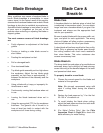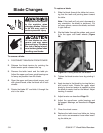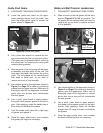
G0640X 17" Wood/Metal Bandsaw
-35-
Cutting Curves
When cutting curves, simultaneously feed and
turn the stock carefully so that the blade follows
the layout line without twisting. If a curve is so
abrupt that you must repeatedly back up and cut a
new kerf, use a narrower blade, a blade with more
TPI (teeth per inch), or make more relief cuts.
Always make short cuts first, then proceed to
the longer cuts. Relief cuts will also reduce the
chance that the blade will be pinched or twisted.
Relief cuts
are cuts made through the waste
portion of the workpiece and are stopped at the
layout line. As you cut along the layout line, waste
wood is released from the workpiece, alleviating
any pressure on the back of the blade.
Stacked Cuts
One of the benefits of a bandsaw is its ability to
cut multiple copies of a particular shape by stack
-
ing a number of workpieces together. Before mak
-
ing stacked cuts, ensure that both the table and
the blade are properly adjusted to 90°. Otherwise,
any error will be compounded.
To complete a stacked cut:
1. Align your pieces from top to bottom to
ensure that each piece has adequate scrap
to provide a clean, unhampered cut.
2. Secure all the pieces together in a manner
that will not interfere with the cutting. Hot
glue on the edges works well, as do brad
nails through the waste portion. (Be careful
not to cut into the brads or you may break the
blade!)
3. On the face of the top piece, lay out the
shape you intend to cut.
4. Make relief cuts perpendicular to the out-
line of your intended shape in areas where
changes in blade direction could strain the
woodgrain or cause the blade to bind.
5. Cut the stack of pieces as though you were
cutting a single piece. Follow your layout line
with the blade kerf on the waste side of your
line, as shown in
Figure 46.
Figure 46. Typical stacked cut.
Cutting Circles
Bandsaws can cut circles with the use of a shop-
built or aftermarket jig. Typically, these jigs work
on the same principal as a drafting compass.
Figure 47 below shows a generic shop built jig
that can be easily made of wood, dowels, and
wood screws. To set it up, advance the jig forward
until the stop dowel hits the table, then pencil a
square "radius" line across the jig. A nail can be
placed anywhere on the radius line, depending on
the size of the desired circle. Draw an X across
the bottom of the workpiece and drill a small pivot
hole in the center of the X to place on the nail.
Place the workpiece on the nail, advance the jig to
the stop dowel, place rear dowel, then cut circle.
Figure 47. Example shop-built circle cutting jig.


















